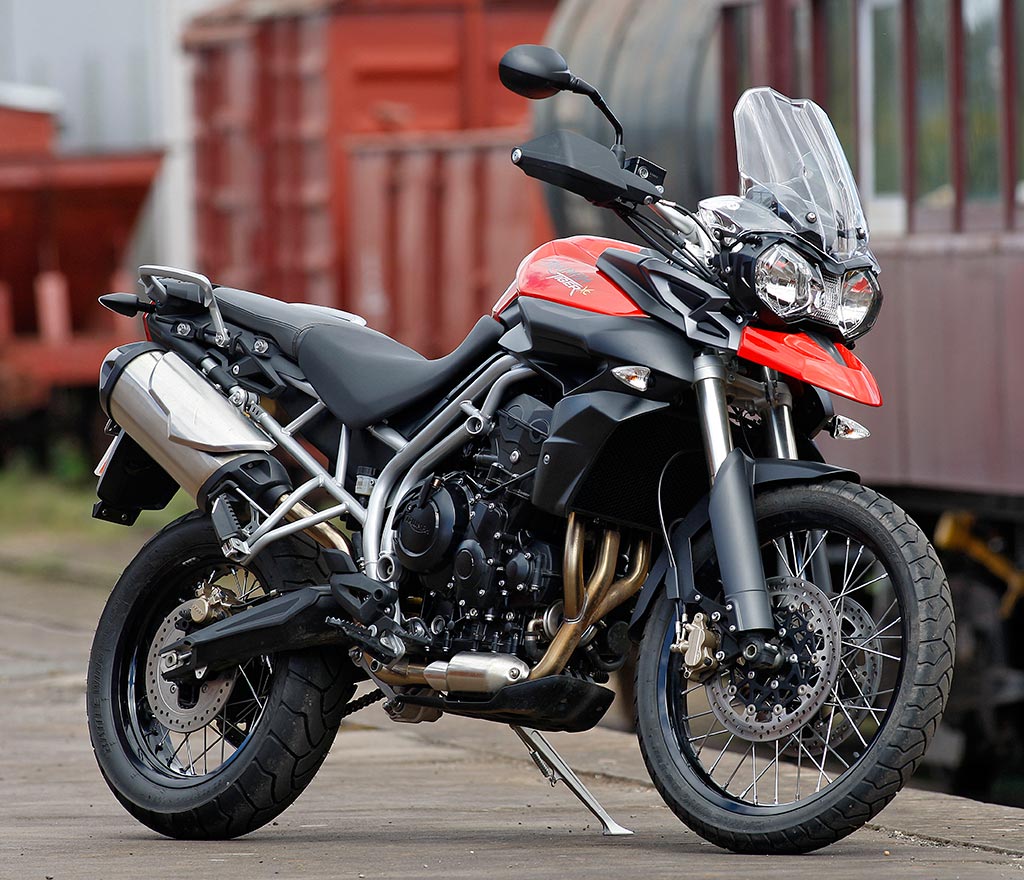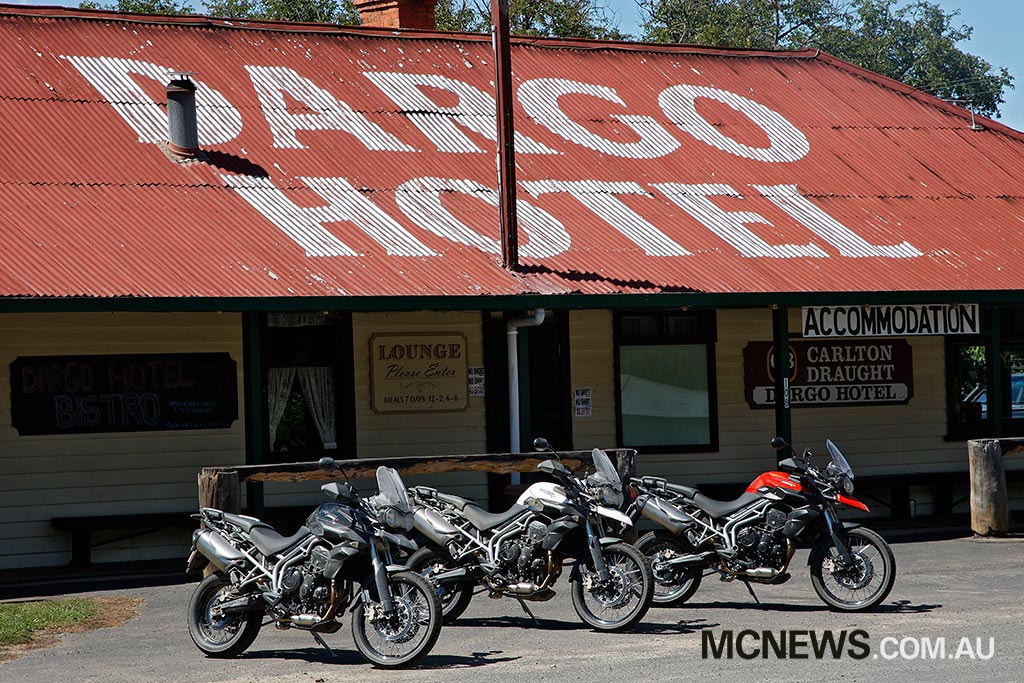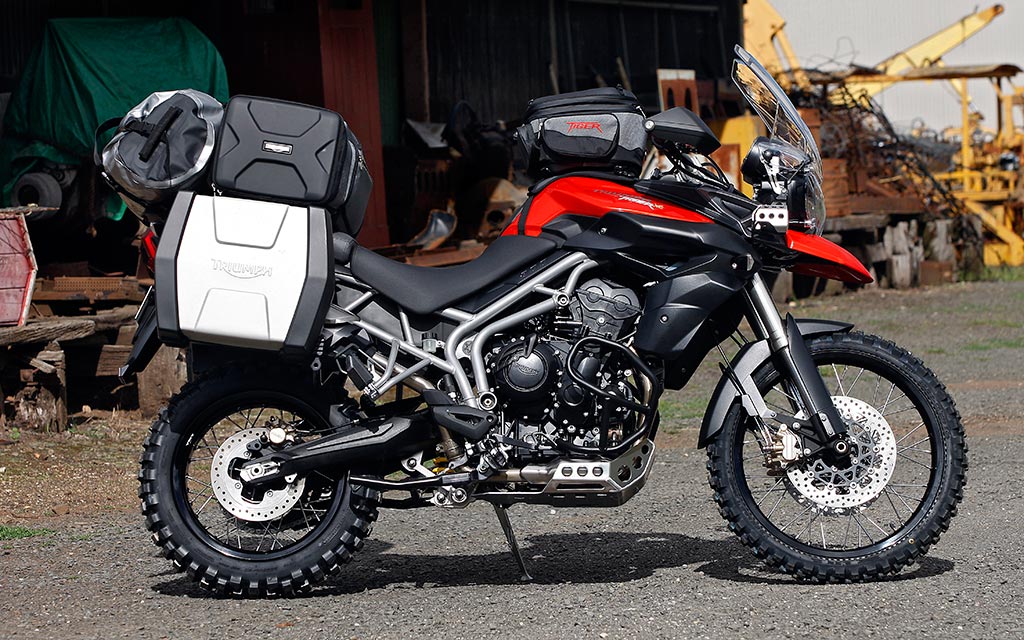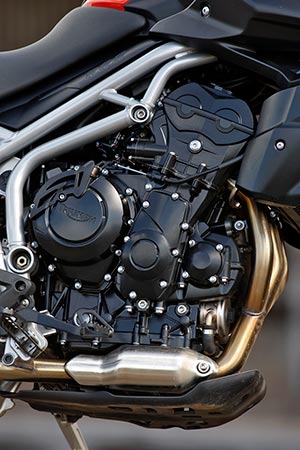Triumph gets adventurous
British manufacturer, Triumph, have taken aim at another sector of the motorcycle market with the launch of their all new Triumph Tiger 800 XC adventure-touring mount. Designed from the ground up (with Charlie and Ewan types in mind) the new triple has been worth the wait.
I have traditionally not been a big fan of Triumph’s larger capacity triples. Always a bit too rough, brash and uncultured for my liking. Then came the sweet little 675 triple that proved great things really do come in small packages. Absolutely brilliant in almost every way (except a little too buzzy and high revving for any highway work) and always up for a good time.
Triumph have taken those 675 basics, changed almost everything apart from the underlying design principles and come up with their best triple yet. The new 800 is one sweet mill.
Sharing the same bore size as the 675, the boost to 799cc comes via a longer stroke, the engine still loves revs and is as eager to spin as its little brother. Triumph claim 94hp at 9300rpm but to be honest the engine feels stronger than that. It’s 79Nm of torque peaks at 7850rpm but 70% of that grunt is available from 4000rpm and the engine will pull top gear from a little over 2000rpm without too many grumbles.
The EFI is by far the best sorted of any bike ever to exit the Hinckley factory. This new triple pulls well from down low before building into a strong mid-range that eventually plateaus at the top. A unique engine that takes a little time to get the best out of; it’s flexible but spins quite easily and has a wide over-rev facility which lures you into carrying more revs than required. By learning to short shift a little and work to its strengths of character the relationship is formalised and the marriage between rider and machine takes the relationship to a new level.
The engine is so responsive that for inexperienced riders the Tiger XC may prove a little too urgent in response to throttle inputs. This is on standard Battle Wing tyres with a bit of a hoon of a rider and shows how much fun the Tiger XC is, but if sliding around is not really you then for off-road work a bike with less cylinders is probably more for you.
A couple of the bikes on the launch did start running rough when the vacuum line running to the MAP sensor worked loose. This was quickly and easily pushed back on and if this becomes a regular problem with later build bikes then Triumph will no doubt secure the hose with a clamp at the factory and retrofit early bikes with the same during routine servicing.
Swapping cogs through the agreeable six-speed box is hardly a chore. Its affability adds to the enjoyment when indulging in the racy side of the machine, as you shuffle up and down the box to keep the engine on the boil and the smile on your dial in the mountains. That said, the engine is quite flexible, but the ease of the task encourages you to get involved and stir the box as you scythe between tight and more open bends. Did I mention the grin factor here? The new Tiger 800 XC has enough charm to give you stretchmarks round to your earholes.
The brakes are suitable for their intended purpose. Twin 308mm disc rotors and Nissin four-piston calipers are high level hardware but the lever does take a fair squeeze to bring out their best. I suspect, however, that this trait was engineered by Triumph to help off-road, where too much initial bite can prove problematic.
An ABS version will also be available further down the track. No ABS machines were available for testing at launch.
Inverted Showa 45mm forks grace the front end of the Tiger 800 XC and provide 220mm of travel, while a progressively sprung remote reservoir Showa shock controls the swingarm through 215mm of travel. The forks are not adjustable while the rear offers preload and rebound damping adjustments.
On fast tarmac a smooth riding style needs to be adopted in order for the long travel suspension to remain composed. This goes for all long travel bikes. Once attuned to this, the Tiger 800 XC offered all the corner carving precision I needed. The machine is quite capable of a cracking pace on the road and the engine just begs to be flogged mercilessly.
Shod with standard fitment Bridgestone Battlewing tyres the Tiger 800 XC performed remarkably well across all surfaces. Where much larger and heavier bikes easily overwhelm these tyres, they suited the Tiger 800 XC quite well.
Slippery off-road sections require a high level of restraint on the more road oriented Bridgestones. Tune your riding to their limitations and a reasonable off-road pace can be sustained. Serious off-roading would require something along the lines of Metzeler Karoo rubber – of course the trade-off comes with much reduced on-road performance and tyre life. The spoked Excel 21” front rim opens up a huge variety of off-road rubber choices and helps make the Tiger 800 XC feel suited to the dirt. The big front hoop takes some getting accustomed to on the road but there is no doubt that the off-road sized spoked rims are the wise choice for a serious adventure machine.
Those that intend to spend virtually all of their time on the road and don’t intend tackling anything more serious than a well-graded fire-trail would be best to go for the base model Tiger 800 with the low travel suspension and cast alloy more road-sized rims.
Ergonomics and comfort are an absolute must for an adventure machine: Triumph have done their homework. The seat appears deceptively narrow and not all that thick for a touring bike, but it is an absolute pearler. In fact, it’s one of the best I’ve ever sampled so don’t let appearances fool you. The 865mm seat height can be lowered to 845mm if so desired. The handlebar risers are also adjustable.
A 19 litre fuel cell is just about adequate for this style of machine. Triumph have worked hard on improving economy so that better than six litres per 100km is achievable, although a true adventure machine needs a bigger tank. To be fair, most of the comparable machines in this size offer similar fuel range, but epic adventures will certainly require strapping on some sort of auxiliary fuel cell.
Thoughtful touches abound like the standard auxiliary power socket positioned right beside the bars with a generously sized 645W generator to power it. A handy lever that toggles the headlight angle between two positions to cater for loading or unloading the machine. A reasonable amount of underseat storage, sturdy luggage rack and tie-down points add greater amenity. Handguards are also standard. I applaud this big picture approach to motorcycle design.
Triumph have produced a huge range of luggage accessories to fully kit out the Tiger 800 XC with up to 200 litres of storage space, big enough for even the longest trans-continental adventure. An adjustable touring screen, alloy sump guard, crash bars, heated grips, driving lights, Arrow exhaust, tyre pressure sensors… The sky’s the limit if there is still anything left in your wallet after shelling out the $16,290 plus on road costs the Tiger 800 XC commands in standard specification.
The digital instrumentation is clear and easy to use with the LCD screen displaying all the usual trip computer functions including distance to empty accompanied by a gear position indicator. It works pretty well and the LCD is of a reasonable resolution and the functionality is great but the finish of the bezel surroundings and the face of the tachometer looks cheap and tacky. The Speed Triple is much the same in this regard which is a pity as it is the area of the machine you spend the most time looking at. The switchgear is also a bit Fisher-Price.
Compared to its rivals in the marketplace such as the BMW F 800 GS the Triumph is by far the most exciting ride on the road. The punchy and responsive engine will make the Triumph a more challenging machine to ride in the dirt, especially for an inexperienced rider. If tackling really snotty trails and more extreme off-road shenanigans the F 800 GS will prove more competent but if finding thrills on the tar is more your game then the Tiger 800 XC is more rewarding on the road.
This is the best bike Triumph have ever made. They’ve worked out where they can try and push the brand into an area they haven’t really been before, sussed out the competition and then delivered a package that ticks all the right boxes while remaining affordable. It is capable enough off-road for its intended purpose, a hoot on the road and is a truly versatile do it all motorcycle. A winner.

Specs – Triumph Tiger 800 XC
Engine – 799cc, liquid cooled, DOHC, in-line 3-cylinder
Bore x Stroke – 74 x 61.9mm
Claimed Power – 94hp @ 9300rpm
Claimed Torque – 79Nm @ 7850rpm
Transmission – Six speed, chain final drive
Seat Height – 865mm (can be lowered to 845mm)
Wet Weight – 215kg
Fuel Capacity – 19 Litres
Average Consumption on test – 6 litres per 100km
Range – 310km
Length – 2215mm
Width – 865mm (At bars)
Rake / Trail – 23.1° / 91.1mm
Height – 1390mm (without mirrors)
Seat Height – 865mm (can be lowered to 845mm)
Wet Weight – 215kg
Tyres – 90/90-21 (F) / 150/70-17 (R)
Warranty – Two years
Price – Expect to pay around $16,290 plus applicable stamp duties and registration charges
Verdict – ****½
Positives
+ Best triple-cylinder mill yet
+ Comfort
+ Versatility
Negatives
– No front suspension adjustment
– Bigger tank would really open up more adventure routes
– Engine perhaps a little aggressive for inexperienced dirt riders
— Pictorials
– Triumph Tiger 800 XC Launch Images
– Triumph Tiger 800 XC Detail Images
– Triumph Tiger 800 XC Fully Optioned Images
— Video – Download 30Mb WMV



British manufacturer, Triumph, have taken aim at another sector of the motorcycle market with the launch of their all new Triumph Tiger 800 XC adventure-touring mount. Designed from the ground up (with Charlie and Ewan types in mind) the new triple has been worth the wait.
I have traditionally not been a big fan of Triumph’s larger capacity triples. Always a bit too rough, brash and uncultured for my liking. Then came the sweet little 675 triple that proved great things really do come in small packages. Absolutely brilliant in almost every way (except a little too buzzy and high revving for any highway work) and always up for a good time.
Triumph have taken those 675 basics, changed almost everything apart from the underlying design principles and come up with their best triple yet. The new 800 is one sweet mill.
Sharing the same bore size as the 675, the boost to 799cc comes via a longer stroke, the engine still loves revs and is as eager to spin as its little brother. Triumph claim 94hp at 9300rpm but to be honest the engine feels stronger than that. It’s 79Nm of torque peaks at 7850rpm but 70% of that grunt is available from 4000rpm and the engine will pull top gear from a little over 2000rpm without too many grumbles.
The EFI is by far the best sorted of any bike ever to exit the Hinckley factory. This new triple pulls well from down low before building into a strong mid-range that eventually plateaus at the top. A unique engine that takes a little time to get the best out of; it’s flexible but spins quite easily and has a wide over-rev facility which lures you into carrying more revs than required. By learning to short shift a little and work to its strengths of character the relationship is formalised and the marriage between rider and machine takes the relationship to a new level.
The engine is so responsive that for inexperienced riders the Tiger XC may prove a little too urgent in response to throttle inputs. Download this video to see what we mean – Download 30Mb WMV – This is on standard Battle Wing tyres with a bit of a hoon of a rider and shows how much fun the Tiger XC is, but if sliding around is not really you then for off-road work a bike with less cylinders is probably more for you.
A couple of the bikes on the launch did start running rough when the vacuum line running to the MAP sensor worked loose. This was quickly and easily pushed back on and if this becomes a regular problem with later build bikes then Triumph will no doubt secure the hose with a clamp at the factory and retrofit early bikes with the same during routine servicing.
Swapping cogs through the agreeable six-speed box is hardly a chore. Its affability adds to the enjoyment when indulging in the racy side of the machine, as you shuffle up and down the box to keep the engine on the boil and the smile on your dial in the mountains. That said, the engine is quite flexible, but the ease of the task encourages you to get involved and stir the box as you scythe between tight and more open bends. Did I mention the grin factor here? The new Tiger 800 XC has enough charm to give you stretchmarks round to your earholes.
The brakes are suitable for their intended purpose. Twin 308mm disc rotors and Nissin four-piston calipers are high level hardware but the lever does take a fair squeeze to bring out their best. I suspect, however, that this trait was engineered by Triumph to help off-road, where too much initial bite can prove problematic.
An ABS version will also be available further down the track. No ABS machines were available for testing at launch.
Inverted Showa 45mm forks grace the front end of the Tiger 800 XC and provide 220mm of travel, while a progressively sprung remote reservoir Showa shock controls the swingarm through 215mm of travel. The forks are not adjustable while the rear offers preload and rebound damping adjustments.
On fast tarmac a smooth riding style needs to be adopted in order for the long travel suspension to remain composed. This goes for all long travel bikes. Once attuned to this, the Tiger 800 XC offered all the corner carving precision I needed. The machine is quite capable of a cracking pace on the road and the engine just begs to be flogged mercilessly.
Shod with standard fitment Bridgestone Battlewing tyres the Tiger 800 XC performed remarkably well across all surfaces. Where much larger and heavier bikes easily overwhelm these tyres, they suited the Tiger 800 XC quite well.
Slippery off-road sections require a high level of restraint on the more road oriented Bridgestones. Tune your riding to their limitations and a reasonable off-road pace can be sustained. Serious off-roading would require something along the lines of Metzeler Karoo rubber – of course the trade-off comes with much reduced on-road performance and tyre life. The spoked Excel 21” front rim opens up a huge variety of off-road rubber choices and helps make the Tiger 800 XC feel suited to the dirt. The big front hoop takes some getting accustomed to on the road but there is no doubt that the off-road sized spoked rims are the wise choice for a serious adventure machine.
Those that intend to spend virtually all of their time on the road and don’t intend tackling anything more serious than a well-graded fire-trail would be best to go for the base model Tiger 800 with the low travel suspension and cast alloy more road-sized rims.
Ergonomics and comfort are an absolute must for an adventure machine: Triumph have done their homework. The seat appears deceptively narrow and not all that thick for a touring bike, but it is an absolute pearler. In fact, it’s one of the best I’ve ever sampled so don’t let appearances fool you. The 865mm seat height can be lowered to 845mm if so desired. The handlebar risers are also adjustable.
A 19 litre fuel cell is just about adequate for this style of machine. Triumph have worked hard on improving economy so that better than six litres per 100km is achievable, although a true adventure machine needs a bigger tank. To be fair, most of the comparable machines in this size offer similar fuel range, but epic adventures will certainly require strapping on some sort of auxiliary fuel cell.
Thoughtful touches abound like the standard auxiliary power socket positioned right beside the bars with a generously sized 645W generator to power it. A handy lever that toggles the headlight angle between two positions to cater for loading or unloading the machine. A reasonable amount of underseat storage, sturdy luggage rack and tie-down points add greater amenity. Handguards are also standard. I applaud this big picture approach to motorcycle design.
Triumph have produced a huge range of luggage accessories to fully kit out the Tiger 800 XC with up to 200 litres of storage space, big enough for even the longest trans-continental adventure. An adjustable touring screen, alloy sump guard, crash bars, heated grips, driving lights, Arrow exhaust, tyre pressure sensors… The sky’s the limit if there is still anything left in your wallet after shelling out the $16,290 plus on road costs the Tiger 800 XC commands in standard specification.
The digital instrumentation is clear and easy to use with the LCD screen displaying all the usual trip computer functions including distance to empty accompanied by a gear position indicator. It works pretty well and the LCD is of a reasonable resolution and the functionality is great but the finish of the bezel surroundings and the face of the tachometer looks cheap and tacky. The Speed Triple is much the same in this regard which is a pity as it is the area of the machine you spend the most time looking at. The switchgear is also a bit Fisher-Price.
Compared to its rivals in the marketplace such as the BMW F 800 GS the Triumph is by far the most exciting ride on the road. The punchy and responsive engine will make the Triumph a more challenging machine to ride in the dirt, especially for an inexperienced rider. If tackling really snotty trails and more extreme off-road shenanigans the F 800 GS will prove more competent but if finding thrills on the tar is more your game then the Tiger 800 XC is more rewarding on the road.
This is the best bike Triumph have ever made. They’ve worked out where they can try and push the brand into an area they haven’t really been before, sussed out the competition and then delivered a package that ticks all the right boxes while remaining affordable. It is capable enough off-road for its intended purpose, a hoot on the road and is a truly versatile do it all motorcycle. A winner.























